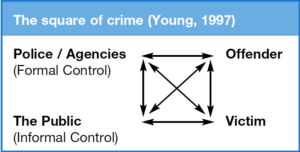
Happy Return of the Light to all my readers! I hope the lengthening days and multifaith holidays of light are giving you some hope, even in the face of some difficult challenges we face (I’ll talk about some of the newest developments regarding COVID in prisons in my next post.)
I’m using this post as a way to organize my ideas for a new chapter in an anthology about animals as victims of crime. One of the most common advocacy paths in animal rights has been an effort to enhance the statutory structure of cruelty to animal laws: creating more offenses, raising sentences, and pursuing prosecutions. As Justin Marceau explains in Beyond Cages, this agenda–which hopes to change the lives of nonhuman animals for the better–tends to target, most of the time, a demographic that is already suffering in serious ways: impoverished people trying to take care of their pets (as I explained elsewhere, the landmark decision State v. Newcomb, in which the Oregon Supreme Court found that removing a dog from the household and testing his blood is not a “search” under the Fourth Amendment, involved precisely that scenario.)
My views on the punitive animus behind so-called progressive movements are well known; in the last few years, I have been alarmed by the amount of mobbing, vindictiveness, and shrill calls for Draconian punishment in the guise of seeking social justice, and this regrettable phenomenon shows no sign of abating, even as more and more people are vocal about how fed up they are with it and how, again and again, it targets the wrong people. More prosecutions deployed against the low-hanging fruit of poor people, as opposed to against the vile factory farm industry, are not the way to go. But there are several ways in which we can support animal liberation through criminal law tools.
The first thing we should consider is what “victim status” actually means–legally, culturally, and symbolically–when said victims don’t actually “use their voice.” Rather, a variety of spokespersons try to assume the role of speaking for the animals. This reminds me, to some extent, the ways in which the parties in a homicide trial try to bring forth the decedent’s perspective, which is of course tragically missing from the trial–but at least there they can rely on the decedent’s history, what they might have said or done when alive. This is not something we can do for animals, though we can and should be enlightened about the extent to which animals can and do suffer, physically and psychologically. Nonetheless, I don’t think that it’s useful to think of the problem of serious crimes against animals through the common formulation of criminal law’s importance for victims–getting “justice for A” by “punishing B.” What would “justice” mean to a nonhuman victim? In one of the most recent conversations about crime survivors and criminal justice, the high-profile trial of Brock Turner, much of the conversation revolved around Chanel Miller’s victim impact statement. What would be the equivalent of such a statement on behalf of an animal? And, more importantly, what would it mean to a nonhuman animal if there were ways to present their perspectives in court?
As you can tell, I have serious doubts about using the “justice for A by punishing B” framework even for human animals, but it seems pretty clear for me that, for nonhumans, symbolic victories of this nature are meaningless. It seems to me that the goal of pro-nonhuman-animal criminal law reform should be making actual, practical headway in animal liberation as well as in animal protectionism. Because of this, I propose the following avenues for reform:
If seeking status for animals in criminal law, we should emphasize ways in which this status actually promotes welfare for animals–such as recognizing harm to animals as “harm to someone” to provide animal rights activists and open rescuers the necessity defense. I think that the common law definition of necessity already supports this interpretation and urge courts to clarify it.
We need to develop better ways to help folks who participate in animal exploitation and abuse as part of a cultural tradition that is important to them (I’m thinking of Katie Young’s ethnography of Hawaiian cockfighters, but Passover lamb slaughter rituals and the U.S. traditional consumption of turkey during Thanksgiving would also count) interrogate their own assumptions about the personhood/sentience of the animals. These questions can be very difficult to explore and we need to find ways to make inroads in these sorts of situations. This also matters when looking at criminal defendants clearly suffering from mental illness, such as animal hoarders, who often believe they are caring for the animals they abuse. Insights that go against the grain of cultural traditions and mental health landscape are very difficult to develop in the context of an adversarial trial, where one is already antagonized by the very fact of being a criminal defendant.
In the area of companion animals, one way to prevent prosecutions before they even happen is to provide people who live in poverty dignified ways to care for their animals, which would be good for the humans as well as the nonhumans. Expanding on the work of Paw Fund and Pets of the Homeless is crucial, as is the financial assistance program of the San Francisco SPCA.
It is surprising how little attention is given in conversations about animals in criminal law to the exploitation of animals in law enforcement. We talk about the racial symbolism of using horses to quell protests for humans (see here also) but not nearly enough about the appalling aspect of involving these horses in human conflicts in this brutal manner (so much of human warfare has relied on animals–you’d think this would be a topic of conversation already.) Contrary to what activists may think, one conversation here does not have to come at the expense of another. This conversation has to go beyond labor rights for police animals (a great example of animal personhood that actually has practical importance!) to questioning their use in the first place.
In Beyond Cages, Marceau proposes shifting the prosecutorial focus from impoverished individuals to corporations; I understand where he’s coming from and empathize with his perspective, though I think that this proposal suffers from the same problems as many anti-carceral proposals: they don’t go far enough–merely expanding the population of “defendants we care about” and leaving the last bastions of carcerality (corporations, rich people, white supremacists, cops) in place. Instead, I think it is wiser to let go of the criminal framework even for corporations, choosing instead to pursue civil liability strategies involving monetary damages, which can potentially incentivize changes in industry standards. The threat of civil action can go hand in hand with the kind of business incentives that Leah Garcés discusses in her book Grilled and Bruce Friedrich promotes at the Good Food Institute.
Does any of you have other ideas for ways in which criminal law can promote animal liberation without the punitive/carceral focus?




No comment yet, add your voice below!